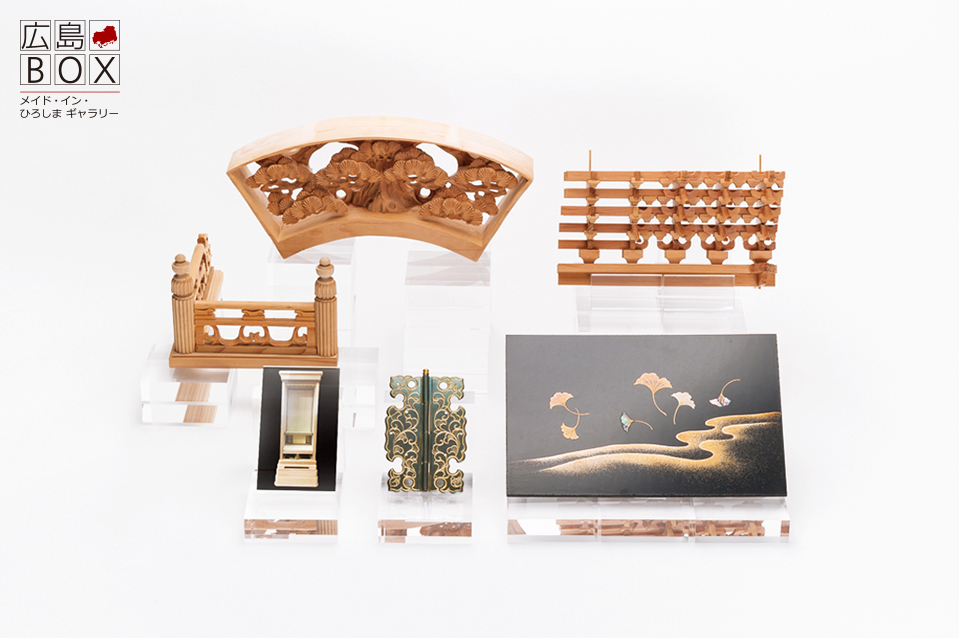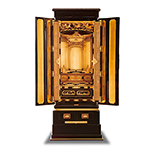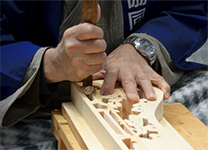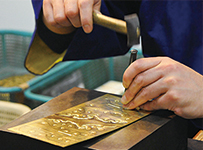Hiroshima Buddhist Altar 02[Traditional Crafts designated by the Minister of Economy, Trade and Industry]Hiroshima Religious Articles Commerce and Industry Cooperative

| Exhibitor (Manufacturer) | Hiroshima Religious Articles Commerce and Industry Cooperative |
|---|---|
| Address | In Mimuramatsu, 2-16 Horikawa-cho, Naka-ku, Hiroshima City, Hiroshima |
| TEL | (082)256-0001 |
| Job description | Manufacture of religious goods |
The most significant characteristic of the “Hiroshima Buddhist altar” is that production processes are divided into seven processes and these processes are collectively referred to as “Nana-sho (seven craftsmen).”
Each process is conducted mostly by hand by traditional craftsmen called “kuden-shi” “shumidan-shi” “sama-shi” “kiji-shi” “kazarikanagu-shi” “”nu-shi” and “makie-shi.” “Hiroshima Buddhist altar” and these series of techniques performed by seven craftsmen were certified in 1978 as Traditional Crafts designated by the Minister of Economy, Trade and Industry.

Parts of Nana-sho
■Kiji-shi (wooden base craftsman)[Far left on the 1st row]
Manufactures the frame of a Buddhist altar such as a “ceiling, pillar, paper screen and door.” These are assembled by “hozo-gumi” without nails.
■Kazarikanagu-shi (Decorative metal fitting craftsman)[2nd from the left on the 1st row]
Manufactures many decorative metal fittings used in Buddhist altars, including hinges and handles of drawers. Materials are copper and bronze and finished by gold/silver plating.
■Nu-shi (Painter) / Makie-shi (Lacquer Craftsman)[3rd from the left on the 1st row]
●Nu-shi (Painter)
Base coating and intermediate coating are applied to the parts of Buddhist altars and finished by painting natural lacquer. Since lacquer dries under certain temperatures and does not allow for any dust, meticulous care and persistence are required.
●Makie-shi (Lacquer Craftsman)
Using special thin writing brushes, called “makie-fude,” designs are painted by lacquer and until lacquer dries, pure gold powder is sprayed. The timing of spraying gold powder is very difficult to judge and this is a job in which the instinct and skill of the craftsmen are demonstrated requiring years to develop.
■Shumidan-shi (Buddha statue pedestal craftsman)[Far left on the 2nd row]
Patterns are painted on wooden materials and the surroundings of a Buddhist altar are carved. After completion of carving, it is assembled by a method known as ki-gumi. This highly detailed work requires years of skill.
■Sama-shi (Interstice craftsman) [2nd from the left of the 2nd row]
The decorative designs carved wood and the transom and palace of each Buddhist altar, using dozens of different carving knives takes many long painstaking hours and days.
■Kuden-shi (Palace Craftsman) [3rd from the left of the 2nd row]
Manufacturing a palace where the Buddha statue is placed. Manufacturing small “masu (boxes”), parts of a palace by carving wooden materials and connects them by assembling in a stair shape.

Carving by Sama-shi

Punching of patterns using a graver by Kazarikanagu-shi





















